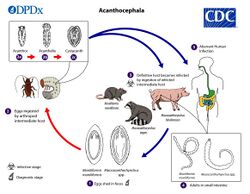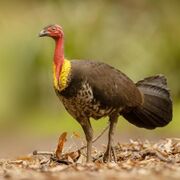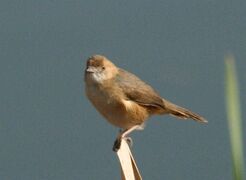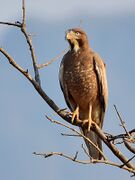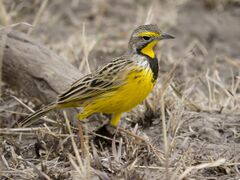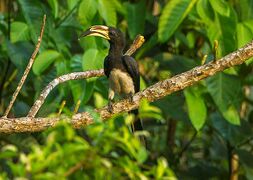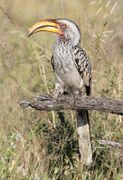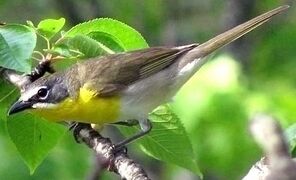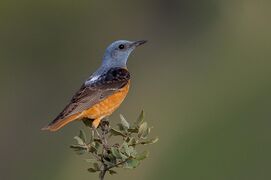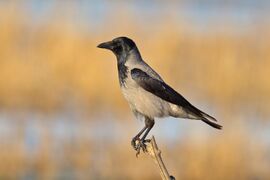Biology:Mediorhynchus
| Mediorhynchus | |
|---|---|
| Scientific classification | |
| Domain: | Eukaryota |
| Kingdom: | Animalia |
| Phylum: | Acanthocephala |
| Class: | Archiacanthocephala |
| Order: | Gigantorhynchida |
| Family: | Gigantorhynchidae |
| Genus: | Mediorhynchus Van Cleave, 1916[1] |
Mediorhynchus is a genus of small parasitic spiny-headed (or thorny-headed) worms.[2] Phylogenetic analysis has been conducted on two known species of Mediorhynchus and confirmed the placement along with the related genus Gigantorhynchus in the family Gigantorhynchida. The distinguishing features of this order among archiacanthocephalans is a divided proboscis (specifically, the presence of a "teloboscis" which is the posterior third of a proboscis). This genus contains fifty-eight species that are distributed globally. These worms exclusively parasitize birds by attaching themselves around the cloaca using their hook-covered proboscis. The bird hosts are of different orders.
Taxonomy
Mediorhynchus is monophyletic based on phylogenetic analysis.[3]
| Archiacanthocephala | |||||||||||||||||||||||||||||||||
| |||||||||||||||||||||||||||||||||
| Phylogenetic reconstruction for select species in the class Archiacanthocephala[4][5] |
Description
Species can be identified primarily morphologically by the arrangement of hooks of the proboscis.[6] The presence of a divided proboscis (specifically, the presence of a "teloboscis" which is the posterior third of a proboscis) is an autapomorphy of Mediorhynchus.[7] Males in some species possess eight cement glands which are used to temporarily close the posterior end of the female after copulation.[8]
Species
There are 59 species in the genus Mediorhynchus.[9][10][lower-alpha 1]
- Mediorhynchus africanus Amin, Evans, Heckmann and El-Naggar, 2013[3]
M. africanus has been found parasitizing the helmeted guinea fowl (Numida meleagris) in Kruger National Park, South Africa , Morocco, Nigeria (reported as Numida ptilorhyncha) and Burkina Faso, and the Yellow-necked spurfowl (Pternistis leucoscepus) in Kenya. One mitochondrial and one nuclear gene sequence confirmed that M. africanus and M. gallinarum are allopatric sister species with 9.7% genetic sequence divergence.[3] It is synonymous with Empodius segmentatus (de Marval, 1902) Southwell et MacFie, 1925 and Mediorhynchus selengensis Harris 1973.[9] The species name africanus is named for the worm's distribution across sub-Saharan Africa.[3]
The trunk is pseudosegmented, flattened laterally, has many prevalent sensory pits, and measures 3.0 to 74.0 mm long by 0.5 to 2.80 mm wide in the male and measures between 4.00 and 110.00 mm long by 0.60 and 4.00 mm wide in the much larger female. There are up to 100 annuli (structures that permits shortening and lengthening of the body by telescoping) in females but fewer in the shorter males. The proboscis is divided by a prominent ridge into two parts: anterior and posterior. The anterior proboscis is pear or apple-shaped with a truncated bare apical end measuring 250 to 339 long by 278 to 478 wide in the male and 300 to 438 long by 330 to 510 wide in the female. The anterior proboscis has two prominent apical pores and 18 to 22 longitudinal rows of 4 to 6 hooks each. The hooks posteriorly directed and measure between 35 and 76 long with the smallest found anteriorly and the longest in the middle. The posterior proboscis is conically shaped and measures 291 to 332 long by 591 to 689 wide at junction with anterior trunk in the male, and 323 to 365 long by 99 to 745 wide at junction with anterior trunk in the female. Except for the posterior most end, the posterior proboscis is covered in very thin spines that are curved posteriorly or undulating with a total of 26 to 40 longitudinal rows of 2 to 6 spines each measuring 14 to 43 long with the longest spines found anteriorly. The Proboscis receptacle is single-walled with anterior portion encased in jacket of adjacent retractor fibers and measures 0.64 to 1.23 mm long by 0.11 to 0.44 mm wide in the male and 0.64 to 1.80 mm long by 0.11 to 0.55 mm wide in the female. The proboscis retractor muscles are prominent and attached to the proboscis receptacle near its posterior end dorsally. The lemnisci long, digitiform, unequal, and unattached. The shorter lemniscus measure between 1.60 and 3.38 mm long by 0.21 and 0.31 mm wide, with 5 or 6 giant nuclei in the male and measure 1.60 to 5.50 mm long by 0.19 to 0.33 mm wide, with 5 or 6 giant nuclei in the female. Longer lemniscus measures 2.15 to 3.47 mm long by 0.21 to 0.33 mm wide with 6, occasionally 7, giant nuclei in the male and measures 2.12 to 7.31 mm long by 0.19 to 0.62 mm wide with 6 giant nuclei in the female. The male reproductive system is located in the posterior third of trunk and consists of two oblong testes measuring Anterior testis measure 0.37 to 4.10 mm long by 0.30 to 1.10 mm wide and the posterior testis measure 0.32 to 3.15 mm wide. There are eight clustered cement glands larger anteriorly, each with one large central giant nucleus and with independent cement ducts emptying at posterior end of Saefftigen’s pouch, along with prominent common sperm duct. The male gonopore is terminal. The female reproductive system is short and located in the broad and flat posterior end of trunk. The uterine bell contains many large nucleated cells with its dorsal and ventral anterior ends connected to body wall with filaments. The gonopore is sub-ventral occasionally covered by a looping posterior trunk expansion. The eggs are ovoid being 65 to 86 long by 39 to 52 wide.[3]
- Mediorhynchus cambellensis Soota, Srivastava, Glosh, 1969[11]
M. cambellensis has been found infesting the intestine of an oriole and flycatcher on Great Nicobar Island. This worm closely resembles M. armenicum but differs from it in number of proboscis hooks and extent of lemnisci. The male is 9.13 mm long and 1.2 mm wide whereas the female is larger measuring 13 to 16 mm long and 2 mm wide. The proboscis is short and club shaped and 0.83 mm long in the male and 1.0 mm long in the female. The distal portion of the proboscis is truncated, the proximal portion is conical, and the proboscis receptacle 0.66 mm long. The proboscis hooks are anterior and in seven spiral rows each of 7–9 large hooks, posterior hooks are very numerous and small. The lemnisci are almost equal, measuring 3.15 by 0.25 mm. The testes are almost equal and measure 1.2 by 0.44 mm and the eggs measure 0.055 by 0.033 mm. There are four pairs of cement glands that are difficult to distinguish. The species name, cambellensis was named after the location the hosts were caught, Campbell Bay.[11]
- Mediorhynchus centurorum Nickol, 1969
M. centurorum was found in the egg and larval forms in Pennsylvania wood cockroach (Parcoblatta pensylvanica). In the laboratory setting, these worms were found to infect red-bellied woodpeckers (Melanerpes carolinus), red-headed woodpeckers (Melanerpes erythrocephalus), Northern flicker, (Colaptes auratus); and a hairy woodpecker, (Dendrocopos villosus) with a mean prepatent period of 35 days. Cystacanths fed to starlings (Sturnus vaulgaris), and red-winged blackbirds, Agelaius phoeniceus, did not produce infections.[12] The eggs have 4 membranes, are 55 um long and have an elongation ratio of 1.53.[13]
- Mediorhynchus channapettae George and Nadakal, 1984[14]
M. channapettae has been found birds of Kerala, India .[14]
- Mediorhynchus cisticolae Smales, 2011[15]
M. cisticolae has been found infesting the Red-faced cisticola (Cisticola erythrops) which is the type host, in the Cote D'Ivoire. The species name cisticolae is named after the host genus Cisticola.[15]
- Mediorhynchus colluricinclae Smales, 2002[16]
- M. colluricinclae has been found parasitizing pomatostomatids in South Australian.[16] The eggs are 51.5 um long and have an elongation ratio of 1.34.[13]
- Mediorhynchus conirostris Ward, 1966
M. conirostris parasitizes rodents in Egypt and has a proboscis which contains 16 to 20 longitudinal rows of four to five hooks.[17]
- Mediorhynchus corcoracis Johnston and Edmonds, 1950[18]
M. corcoracis was found parasitising the white-winged chough (Corcorax melanorhamphos) in New South Wales, Queensland, Victoria, and South Australia, Australia . It is named after the genus name of the host species Corcorax. It is also found in several species of crow including the little crow Corvus bennetti from , the Australian raven Corvus coronoides, and the little raven Corvus mellori all from South Australia. It has also been found in the Australian Magpie-lark (Grallina cyanoleuca).[16]
- Mediorhynchus edmondsi Schmidt and Kuntz, 1977[6]
- Mediorhynchus emberizae (Rudolphi, 1819)[19][lower-alpha 2]
M. emberizae is found infesting the intestines of the red-cowled cardinal (Paroaria dominicana) in the State of Bahia, Brazil.[20]
- Mediorhynchus empodius (Skrjabin, 1913)
- Mediorhynchus fatimaae Khan, Bilqees and Muti-ur-Rehman, 2004[21]
M. fatimaae has been found parasitizing the White-eyed buzzard (Burastur teesa) in Karachi, Pakistan . It is distinguished mainly by a unique proboscis armature of 10–12 longitudinal rows having 7–8 hooks and 10 longitudinal rows having 7–8 spines and eggs measuring 0.041–0.045 mm by 0.015–0.018 mm.[21]
- Mediorhynchus gallinarum (Bhalerao, 1937)[22]
M. gallinarum was found infecting chickens (Gallus gallus) in India , other Asian countries,[3] and Africa.[17] M. gallinarum is similar to M. africanus however specimens from Indonesia and elsewhere are cylindrical and non-segmented, the proboscis has 18 to 22 longitudinal rows of four to five hooks[17] and lacks prominent apical pores, sensory pits are rare on the trunk, the posterior end of the female is pointed with a terminal gonopore, and the eggs are smaller.[3]
- Mediorhynchus gibsoni Bilqees, Khan, Khatoon and Khatoon, 2007[23]
M. gibsoni was found infesting the White-eyed buzzard (Butastur teesa) in Karachi, Sindh, Pakistan . The worm has a long pseudosegmented body with a short neck. The proboscis is long with a sac-like receptacle and possesses 25 circular longitudinal rows of between 8 and 12 hooks at the anterior region, and 10 rows of 8 to 16 spines at the posterior region. The two testes are oval and there are eight cement glands.[23]
- Mediorhynchus giganteus Meyer, 1931
M. giganteus has been found parasitizing the domestic turkey (Meleagris gallopavo) in East Africa. The proboscis has about 14 longitudinal rows of five hooks with a maximum body length of 11 cm found in a female.[17]
- Mediorhynchus grandis Van Cleave, 1916 [1]
M. grandis has been found in the small intestine of the Common grackle (Quiscalus quiscula) in Maryland, New Jersey, Kansas , Illinois, Kentucky, the American crow (Corvus brachyrhynchos) in Maryland and Ohio, Eastern meadowlark (Sturnella magna) in North Carolina, Ohio, Illinois, Oklahoma, and Texas , Red-winged blackbird (Agelaius phoeniceus)) in Ohio and Texas, Rusty blackbird (Euphagus carolinus) in Illinois, Brown-headed cowbird (Molothrus ater) in Texas, the Saltmarsh sparrow (Ammospiza caudacutus) or a Nelson's sparrow (Ammospiza nelsoni)[lower-alpha 3] in Texas and the American robin (Turdus migratorius) in Ohio. Females are 27 to 51 mm long and 0.8 to 1.44 wide, whereas the males are smaller being 7 to 12 mm long and 0.6 to 0.8 mm wide. The proboscis is cone-shaped and 0.57 to 0.86 mm long and is divided into anterior and posterior portions. The anterior portion of the proboscis has 18 longitudinal rows of hooks each with 4 to 5 hooks (averaging a total of 76 hooks), and each hook having posteriorly directed roots. The posterior region of the proboscis has around 30 longitudinal rows of small hooks each with 4 to 6 hooks (averaging a total of 130).There are five to eight pyriform cement glands. Testes are oval (0.98 to 1.03 mm by 0.26 to 0.35 mm). Leminsci are filiform and have 6 nuclei each.[25] The worms have been found in the intermediate host, grasshoppers.[12] The eggs have 4 membranes, are 47.5 um long and have an elongation ratio of 1.86.[13]
- Mediorhynchus indicus Varghese-George, Mathai-Nadakal, Kunjanpillai-Vijayakumaran and Rajendran, 1981
- Mediorhynchus kuntzi Ward, 1960
M. kuntzi has been found parasitizing curlews (Numenius) in Egypt. The proboscis has 24 rows of five to six hooks.[17]
- Mediorhynchus lanius Amin, Nguyen, and Heckmann, 2008[26]
M. Mediorhynchus lanius has been found infesting the Long-tailed shrike (Lanius schach) in the Quang Ninh Province, Vietnam. It is named after the genus name of the host species Lanius[26]
- Mediorhynchus lagodekhiensis Kuraschvili, 1955
- Mediorhynchus leptis Ward, 1966
M. leptis has been found parasitizing the Common kestrel (Falco tinnunculus) in Egypt. The proboscis has 22 longitudinal rows of five to six hooks.[17]
- Mediorhynchus lophurae Wang, 1966
M. lophurae is a parasite of the Silver pheasant (Lophura nycthemera) and is found in Lang Son, Vietnam.[27]
- Mediorhynchus mariae George and Nadakal, 1984
- Mediorhynchus mattei Marchand and Vassiliades, 1982 [17]
M. mattei has been found in the digestive tract of the Northern red-billed hornbill (Tockus erythrorhynchus) which is the type-host in Senegal. Male worms are 2–3 cm in length, females are 3–11 cm in length. It was described in 1982; its name honours French zoologist Xavier Mattei who collected the birds containing this acantocephalan used to identify the species.[17]
- Mediorhynchus meiringi Bisseru, 1960
- Mediorhynchus micranthus (Rudolphi, 1819)
M. micranthus was found infesting the Eurasian skylark (Alauda arvensis) and the Crested lark (Galerida cristata) in the Golestan Province of Iran.[28]
- Mediorhynchus mirabilis (Marval, 1905)
- Mediorhynchus mokgalongi Smales, Halajian, Luus-Powell, and Tavakol, 2018[29]
The proboscis of M. mokgalongi has between 125 and 156 hooks arranged in 24 to 26 longitudinal rows of 24 to 26 hooks followed by 30 rows of 5 to 6 spines.[29] It was found infesting a Karoo Thrush bird (Turdus smithi) in Polokwane, Limpopo Province. South Africa . The parasite was named after Mahlo Mokgalong for his contribution to the field of bird parasitology.[30]
- Mediorhynchus muritensis Lundstrom, 1942
- Mediorhynchus nickoli Khan, Bilqees and Muti-ur-Rehman, 2004[21]
M. nickoli has been found parasitizing the Black kite (Milvus migrans) in Karachi, Pakistan . It is distinguished mainly by a unique proboscis armature of 10 longitudinal rows having 7–8 hooks and six longitudinal rows having 6–8 spines and eggs measuring 0.046–0.051 mm by 0.0076–0.015 mm.[21]
- Mediorhynchus numidae (Baer, 1925)
M. numidae was found infesting the helmeted guinea fowl (Numida meliagris) in Pretoria, Gauteng Province, South Africa . Meyer renamed this species in 1932 from Heteroplus numidae.[31] The proboscis has twelve longitudinal rows of three hooks.[17]
- Mediorhynchus orientalis Belopolskaya, 1953
In an aviary setting, M. orientalis was found infesting the purple starling (Lamprotornis purpureus), Rüppell's starling (Lamprotornis purpuroptera), and the Bali myna (Leucopsar rothschildi) with the intermediate hosts being the Surinam cockroach (Pycnoscelus surinamensis) and the American cockroach (Periplaneta americana).[32] The eggs are 53 um long and have an elongation ratio of 2.12.[13]
- Mediorhynchus oswaldocruzi Travassos, 1923
- Mediorhynchus otidis (Miescher, 1841)
- Mediorhynchus pandei Bhattacharya, 2007
- Mediorhynchus papillosus Van Cleave, 1916[1]
M papillosus was found infesting the rufous-collared sparrows, (Zonotrichia capensis) in northern and central Chile.[33] The eggs are 42.5 um long and have an elongation ratio of 2.02.[13] It is the type species of the genus.[34] M. bakeri but was found to be a junior synonym[10] was found infesting the small intestines of the Northern bobwhite (Colinus virginianus) in Leon County, Florida.[35]
M. alecturae (Johnston and Edmonds, 1947)[36][lower-alpha 4] is considreded a junior synonym of M papillosus.[26] It occurs only in the Australian brushturkey (Alectura lathami) and located in Queensland, Australia. It is named after the genus name of the host species Alectura.[36][16]
- Mediorhynchus passerus Das, 1951
- Mediorhynchus pauciuncinatus Dollfus, 1959
- Mediorhynchus peckeri Bhattacharya, 1999
- Mediorhynchus peruensis Moya, Martinez and Tantalean, 2011[37]
M. peruensis was found infesting the Chiguanco thrush (Turdus chiguanco) in Peru.[37]
- Mediorhynchus petrochenkoi Gvosdev and Soboleva, 1966
- Mediorhynchus pintoi Travassos, 1923
M. pintoi was found infesting the Spotted nothura (Nothura maculosa) from Minas Gerais, Brazil . Only a damaged female specimen was discovered, and the original description is lost.[38]
- Mediorhynchus quilonensis Bhattacharya, 2007
- Mediorhynchus rajasthanensis Gupta, 1976
- Mediorhynchus robustus Van Cleave, 1916[1]
M. robustus was found infesting the intestines of a Yellow-breasted chat (Icteria virens) in Washington (state) , United States and the Long-tailed Meadowlark (Sturnella loyca) in the Biobío Region, Chile . The largest hooks are 38 microns. The intermediate hosts for this worm are unknown. M. Robustus has been found in larval cystacanth form the Raccoon dog (Nyctereutes procyonoides) in Japan , but this is likely a dead end host since all known final hosts for this species are Passeriformes.[39] The eggs are 38 um long and have an elongation ratio of 2.38.[13]
- Mediorhynchus rodensis Cosin, 1971
M. rodensis was found in the small intestine of the Eurasian jay (Garrulus glandarius) in Lakatnik in the Vrachanska Planina mountains of Bulgaria.[40]
- Mediorhynchus sipocotensis Tubangui, 1935[41]
M. sipocotensis was found parasitizing the American robin (Turdus migratorius) in Marion County, Indiana. The worms possess a globular proboscis armed with concentric spines and a sac-like body with no spines on the trunk. They also have large unfragmented epidermal nuclei. The females possess two ligament sacs, and the males possess eight cement glands.[42]
- Mediorhynchus spinaepaucitas Smales, 2011[15]
M. spinaepaucitas has been found infesting the Yellow-throated longclaw (Macronyx croceus) in the Cote D'Ivoire.[15]
- Mediorhynchus taeniatus (Linstow, 1901)
M. taeniatus has been found infesting the African pied hornbill (Tockus fasciatus) in the Cote D'Ivoire.[15] It has also been found infesting the helmeted guinea fowl (Numida meliagris) in Kimberley, Northern Cape Province, South Africa and the Southern Yellow-billed Hornbill (Tockus leucomelas) in Limpopo Province, South Africa . It was renamed from Echinorhynchus taeniatus to its present name by Dollfus in 1936.[31]
- Mediorhynchus tanagrae (Rudolphi, 1819)
- Mediorhynchus tenuis Meyer, 1931
M. tenuis was found in the small intestine of the Common rock thrush (Monticola saxatilis) in the Iskarskoto defile in the Vrachanska Planina mountains of Bulgaria.[40] It is also found in passeriforms in North Africa. The proboscis has 24 longitudinal rows of four to five hooks.[17]
- Mediorhynchus textori Barus, Six and Majumdar, 1978
M. textori is a parasite of the Village weaver (Ploceus cucullatus reported as the synonym Textor cucullatus) in Ghana. The proboscis has 10 to 11 longitudinal rows of nine to ten hooks.[17] The eggs are 62.5 um long and have an elongation ratio of 1.54.[13]
- Mediorhynchus thrushi Bhattacharya, 2000
- Mediorhynchus turdi Smales, 2011[15]
M. turdi has been found infesting the African thrush (Turdus pelios) in the Cote D'Ivoire. The species name turdi derives from the genus name of the type host Turdus.[15]
- Mediorhynchus turnixena (Tubangui, 1931)[lower-alpha 5][43]
M. turnixena was found infesting the Spotted buttonquail (Turnix ocellata) in the Philippines .[43]
- Mediorhynchus vaginatus (Diesing, 1851)[lower-alpha 6]
M. vaginatus was found infesting the Green aracari (Pteroglossus viridis), the Channel-billed toucan (Ramphastos vitellinus reported as Rhamphastus culminatus), a Cock-of-the-rock (reported as Rupicola crocea) and the bobolink (Dolichonyx oryzivorus).[34]
- Mediorhynchus vancleavei (Lundstrom, 1942)[lower-alpha 7]
M. vancleavei is a parasite of birds in Sweden including the Common sandpiper (Actitis hypoleucos reported as Tringa hypoleucos).[34] The species name vancleavei is derived from the named of American parasitologist Harley Jones Van Cleave who originally named the genus Mediorhynchus.
- Mediorhynchus wardi Schmidt and Canaris, 1967[44]
M. wardi is a parasite of passeriforms in Kenya. The proboscis has 24 to 26 longitudinal rows of six to eight hooks.[17] The eggs are 52 um long and have an elongation ratio of 1.68.[13]
- Mediorhynchus zosteropis (Porta, 1913)[45][lower-alpha 8]
M. zosteropis was found in the small intestine of the Hooded crow (Corvus cornix) in the Vratsa in the Vrachanska Planina mountains of Bulgaria and generally distributed in New Caledonia and the Palaearctic.[40] It is also reported in the Muscicapidae Diaphanopterus naevius similimus and the silvereye (Zosterops lateralis) in New Caledonia.[34]
Hosts
The life cycle of an acanthocephalan consists of three stages beginning when an infective acanthor (development of an egg) is released from the intestines of the definitive host and then ingested by an arthropod, the intermediate host. The intermediate hosts of Mediorhynchus are insects including grasshoppers and cockroaches. When the acanthor molts, the second stage called the acanthella begins. This stage involves penetrating the wall of the mesenteron or the intestine of the intermediate host and growing. The final stage is the infective cystacanth which is the larval or juvenile state of an Acanthocephalan, differing from the adult only in size and stage of sexual development. The cystacanths within the intermediate hosts are consumed by the definitive host, usually attaching to the walls of the intestines, and as adults they reproduce sexually in the intestines. The acanthor are passed in the feces of the definitive host and the cycle repeats. There are no known paratenic hosts (hosts where parasites infest but do not undergo larval development or sexual reproduction) for Mediorhynchus.[48]
Mediorhynchus species exclusively parasitize avian hosts. There are no reported cases of Mediorhynchus infesting humans in the English language medical literature.[47]
- Hosts for Mediorhynchus species
The Helmeted guineafowl is a host of M. africanus, M. numidae, and M. taeniatus
The Australian brushturkey is a host of M. alecturae
The Red-faced cisticola is a host of M. cisticolae
The White-eyed buzzard is a host of M. fatimaae
The Yellow-throated longclaw is a host of M. spinaepaucitas
The northern red-billed hornbill is the type-host of M. mattei
The African pied hornbill is a host of M. taeniatus
The Black kite is a host of M. nickoli
The Yellow-breasted chat is a host of M. robustus
The Eurasian jay is one of the hosts of M. rodensis
The Common rock thrush is one of the hosts of M. tenuis
The Hooded crow is one of the hosts of M. zosteropis
Notes
- ↑ A binomial authority in parentheses indicates that the species was originally described in a genus other than Mediorhynchus.
- ↑ M. emberizae was originally named Echinorhynchus emberizae by Karl Asmund Rudolphi in 1819 but was renamed.
- ↑ Reported as a sharp-tailed sparrow Passerherbulus caudacutus which has been determined to be two species.[24]
- ↑ The species was originally named Empodius alecturae.
- ↑ The species was originally named Empodius turnixena before obtaining its current name.[34]
- ↑ The species was originally named Echinorhynchus vaginatus and was later renamed Empodius vaginatus by Travassos in 1917 before obtaining its current name.[34]
- ↑ The species was originally named Heteracanthothynchus vancleave.[34]
- ↑ M. zosteropis was originally named Centrorhynchus zosteropis by Porta in 1913 but was renamed.[34]
- ↑ There are no known aberrant human infections for Mediorhynchus species.[47]
References
- ↑ 1.0 1.1 1.2 1.3 Cleave, H. J. Van (1916). "Acanthocephala of the Genera Centrorhynchus and Mediorhynchus (New Genus) from North American Birds". Transactions of the American Microscopical Society 35 (4): 221–232. doi:10.2307/3221908. https://www.biodiversitylibrary.org/part/91001.
- ↑ "Subject Index". The Journal of Parasitology 45: 162–286. 1959. ISSN 0022-3395.
- ↑ 3.0 3.1 3.2 3.3 3.4 3.5 3.6 Amin, Omar M.; Evans, Paul; Heckmann, Richard A.; El-Naggar, Atif M. (2013). "The description of Mediorhynchus africanus n. sp. (Acanthocephala: Gigantorhynchidae) from galliform birds in Africa". Parasitology Research 112 (8): 2897–2906. doi:10.1007/s00436-013-3461-9. PMID 23722716.
- ↑ Nascimento Gomes, Ana Paula; Cesário, Clarice Silva; Olifiers, Natalie; de Cassia Bianchi, Rita; Maldonado, Arnaldo; Vilela, Roberto do Val (December 2019). "New morphological and genetic data of Gigantorhynchus echinodiscus (Diesing, 1851) (Acanthocephala: Archiacanthocephala) in the giant anteater Myrmecophaga tridactyla Linnaeus, 1758 (Pilosa: Myrmecophagidae)". International Journal for Parasitology: Parasites and Wildlife 10: 281–288. doi:10.1016/j.ijppaw.2019.09.008. PMID 31867208.
- ↑ Amin, O.M.; Sharifdini, M.; Heckmann, R.A.; Zarean, M. (2020). "New perspectives on Nephridiacanthus major (Acanthocephala: Oligacanthorhynchidae) collected from hedgehogs in Iran". Journal of Helminthology 94: e133. doi:10.1017/S0022149X20000073. PMID 32114988.
- ↑ 6.0 6.1 Schmidt, Gerald D.; Kuntz, Robert E. (1977). "Revision of Mediorhynchus van Cleave 1916 (Acanthocephala) with a Key to Species". The Journal of Parasitology 63 (3): 500–507. doi:10.2307/3280011. PMID 559066.
- ↑ Monks, Scott (2001). "Phylogeny of the Acanthocephala based on morphological characters". Systematic Parasitology 48 (2): 81–115. doi:10.1023/A:1006400207434. PMID 11252279.
- ↑ Bush, Albert O.; Fernández, Jacqueline C.; Esch, Gerald W.; Seed, J. Richard (2001). Parasitism : the diversity and ecology of animal parasites. Cambridge, UK New York, NY: Cambridge University Press. p. 203. ISBN 0-521-66278-8. OCLC 44131774.
- ↑ 9.0 9.1 Amin, Omar M. (19 September 2013). "Classification of the Acanthocephala". Folia Parasitologica 60 (4): 273–305. doi:10.14411/fp.2013.031. PMID 24261131.
- ↑ 10.0 10.1 "Mediorhynchus Van Cleave, 1916". November 23, 2019. https://www.itis.gov/servlet/SingleRpt/SingleRpt?search_topic=TSN&search_value=196489.
- ↑ 11.0 11.1 Studies on the helminth fauna of the Great Nicobar Island
- ↑ 12.0 12.1 Nickol, Brent B. (1977). "Life History and Host Specificity of Mediorhynchus centurorum Nickol 1969 (Acanthocephala: Gigantorhynchidae)". The Journal of Parasitology 63 (1): 104–111. doi:10.2307/3280112. PMID 845719. http://digitalcommons.unl.edu/cgi/viewcontent.cgi?article=1365&context=parasitologyfacpubs.
- ↑ 13.0 13.1 13.2 13.3 13.4 13.5 13.6 13.7 Pfenning, A. C. (2017). Egg morphology, dispersal, and transmission in acanthocephalan parasites: integrating phylogenetic and ecological approaches.Url=https://via.library.depaul.edu/cgi/viewcontent.cgi?article=1273&context=csh_etd
- ↑ 14.0 14.1 George, P. V.; Nadakal, M. (1984). "Three new species of Acanthocephala (Gigantorhynchidea) from birds of Kerala". Acta Parasitologica Polonica 29 (9–19): 97–105.
- ↑ 15.0 15.1 15.2 15.3 15.4 15.5 15.6 Smales, Lesley R. (2011). "Gigantorhynchidae (Acanthocephala) Including the Description of New Species of Mediorhynchus from Birds from the Côte d'Ivoire, Africa". Comparative Parasitology 78 (2): 316–326. doi:10.1654/4510.1.
- ↑ 16.0 16.1 16.2 16.3 Smales, L. R. (April 2002). "Species of Mediorhynchus (Acanthocephala: Gigantorhynchidae) in Australian Birds with the Description of Mediorhynchus colluricinclae n. sp". Journal of Parasitology 88 (2): 375–381. doi:10.1645/0022-3395(2002)088[0375:SOMAGI2.0.CO;2]. PMID 12054015.
- ↑ 17.00 17.01 17.02 17.03 17.04 17.05 17.06 17.07 17.08 17.09 17.10 17.11 Marchand, Bernard; Vassiliades, Georges (December 1982). "Mediorhynchus mattei sp. n. (Acanthocephala, Giganthorhynchidae) from Tockus erythrorhynchus (Aves), the Red-Beaked Hornbill, in West Africa". The Journal of Parasitology 68 (6): 1142. doi:10.2307/3281107.
- ↑ Johnston & Edmonds, 1950 : Australian Acanthocephala n° 8. Transactions of the Royal Society of South Australia, vol.74, p.1–5 url=https://www.biodiversitylibrary.org/item/128927#page/5/mode/1up.
- ↑ Rudolphi, Karl Asmund (1819). Entozoorum synopsis cui accedunt mantissa duplex et indices locupletissimi. doi:10.5962/bhl.title.9157. OCLC 9091261. https://www.biodiversitylibrary.org/item/37488.
- ↑ Carvalho, Adriano R.; Souza-Lima, Sueli; Tavares, Luiz E. R.; Luque, José L. (2008). "Relationship between biomass and parasite density of Mediorhynchus emberizae (Acanthocephala: Gigantorhynchidae) parasites of Paroaria dominicana (Passeriformes: Emberizidae) of the State of Bahia, Brazil". Revista Brasileira de Parasitologia Veterinária 17 (2): 118–121. doi:10.1590/S1984-29612008000200012. PMID 18823583.
- ↑ 21.0 21.1 21.2 21.3 Khan, Aly; Bilqees, Fatima Mujib; Rehman, Muti-Ur (2004). "Two New Species of Genus Mediorhynchus Van Cleave, 1916 from Birds of Karachi". Pakistan Journal of Zoology 36 (2): 139–142. https://zsp.com.pk/pdf36/PJZ-16403.pdf.
- ↑ Bhalerao, G. D. (July 1937). "12. On a remarkable Acanthocephala from a Fowl in India". Proceedings of the Zoological Society of London B107 (2): 199–203. doi:10.1111/j.1096-3642.1937.tb00002.x.
- ↑ 23.0 23.1 Bilqees, F. M., Khan, A., Khatoon, N., & Khatoon, S. (2007). Acanthocephala from eagle of Karachi with descriptions of two new species. Proceedings of Parasitology (Pakistan).
- ↑ Rising, James D.; Avise, John C. (1993). "Application of Genealogical-Concordance Principles to the Taxonomy and Evolutionary History of the Sharp-Tailed Sparrow (Ammodramus caudacutus)". The Auk 110 (4): 844–856. doi:10.2307/4088638.
- ↑ Moore, Donald V. (1962). "Morphology, Life History, and Development of the Acanthocephalan Mediorhynchus grandis Van Cleave, 1916". The Journal of Parasitology 48 (1): 76–86. doi:10.2307/3275416.
- ↑ 26.0 26.1 26.2 Amin, Omar M.; Ha, Nguyen Van; Heckmann, Richard A. (2008). "Four New Species of Acanthocephalans from Birds in Vietnam". Comparative Parasitology 75 (2): 200–214. doi:10.1654/4320.1.
- ↑ Van Ha, N. (2015). An updated list of Acanthocephalans (Acanthocephala) from animals in Vietnam. TAP CHI SINH HOC, 37(3), 384–394.
- ↑ Tavakol, Sareh; Amin, Omar M.; Luus-Powell, Wilmien J.; Halajian, Ali (22 October 2015). "The acanthocephalan fauna of Iran, a check list". Zootaxa 4033 (2): 237–258. doi:10.11646/zootaxa.4033.2.3. PMID 26624401.
- ↑ 29.0 29.1 Smales, Lesley R.; Halajian, Ali; Luus-Powell, Wilmien J.; Tavakol, Sareh (2018). "Acanthocephalans, Including the Description of a New Species of Mediorhynchus (Gigantorhynchidae) and a Redescription of Centrorhynchus clitorideus (Centrorhynchidae) from Vertebrate Hosts from South Africa". Comparative Parasitology 85: 95–106. doi:10.1654/1525-2647-85.1.95.
- ↑ :University of Limpopo:
- ↑ 31.0 31.1 Halajian, Ali; Warner, Lesley R.; Tavakol, Sareh; Smit, Nico J.; Luus-Powell, Wilmien J. (2018). "Checklist of acanthocephalan parasites of South Africa". ZooKeys (789): 1–18. doi:10.3897/zookeys.789.27710. PMID 30344432.
- ↑ Bolette, David P. (1990). "Intermediate Host of Mediorhynchus orientalis (Acanthocephala: Gigantorhynchidae)". The Journal of Parasitology 76 (4): 575–577. doi:10.2307/3282844. PMID 2380868.
- ↑ Llanos-Soto, Sebastián; Muñoz, Braulio; Moreno, Lucila; Landaeta-Aqueveque, Carlos; Kinsella, John Mike; Mironov, Sergey; Cicchino, Armando; Barrientos, Carlos et al. (2017). "External and gastrointestinal parasites of the rufous-collared sparrow Zonotrichia capensis (Passeriformes, Emberizidae) in Chile". Revista Brasileira de Parasitologia Veterinária 26 (3): 314–322. doi:10.1590/s1984-29612017043. PMID 28977245.
- ↑ 34.0 34.1 34.2 34.3 34.4 34.5 34.6 34.7 Golvan, Yves-J. (1962). "Le phylum des Acanthocephala. (Quatrième note). La classe des Archiacanthocephala (A. Meyer 1931)". Annales de Parasitologie Humaine et Comparée 37 (1–2): 1–72. doi:10.1051/parasite/1962371001. PMID 13900032. https://www.parasite-journal.org/articles/parasite/pdf/1962/01/parasite1962371p1.pdf. Retrieved February 29, 2020.
- ↑ Byrd, Elon E.; Kellogg, Forest E. (1971). "Mediorhynchus bakeri, a New Acanthocephalan (Gigantorhynchidae) from the Bob-White, Colinus virginianus virginianus (L.)". The Journal of Parasitology 57 (1): 137–142. doi:10.2307/3277769.
- ↑ 36.0 36.1 Johnston & Edmonds, 1947 : Australian Acanthocephala n° 6. Records of the South Australian Museum, volume 8, pages 555–562 url=[1]).
- ↑ 37.0 37.1 Moya, Rocío; Martínez, Rosa; Tantaleán, Manuel (9 February 2012). "Nueva especie de Mediorhynchus (Acanthocephala, Gigantorhynchidae) en Turdus chiguanco (Turdidae) de Junín, Perú" (in es). Revista Peruana de Biología 18 (3): 299–302. doi:10.15381/rpb.v18i3.441. Gale A298173137.
- ↑ Magalhães Pinto, Roberto; Knoff, Marcelo; Torres Gomes, Cláudia; Noronha, Dely (2006). "Helminths of the Spotted Nothura, Nothura maculosa (Temminck, 1815) (Aves, Tinamidae) in South America". Parasitología Latinoamericana 61 (3–4). doi:10.4067/S0717-77122006000200009.
- ↑ Soto, Marta; Moreno, Lucila; Sepúlveda, María S.; Kinsella, J. Mike; Mironov, Sergei; González-Acuña, Daniel (1 December 2013). "First records of parasites from the Long-tailed Meadowlark Sturnella loyca (Passeriformes: Icteridae) from the Biobío Region, Chile". Revista Mexicana de Biodiversidad 84 (4): 1316–1320. doi:10.7550/rmb.34112.
- ↑ 40.0 40.1 40.2 Bechev, D., & Georgiev, D. Review of species of the phylum Acanthocephala recorded from Vrachanska Planina Mountains.
- ↑ Tubangui, M. A. (1935). Additional notes on Philippine Acanthocephala. Philippine Journal of Science, 56(1), 13–17.
- ↑ Baker, J. B.; Hamon, J. H. (1967). "Some intestinal parasites of robins from Marion County, Indiana.". Indiana Academy of Science 77: 417–419. https://journals.iupui.edu/index.php/ias/article/download/6915/6897.
- ↑ 43.0 43.1 Tubangui, M. A. (1933). Notes on Acanthocephala in the Philippines. Philippine Journal of Science, 50(2), 115–128.
- ↑ Schmidt, Gerold D.; Canaris, Albert G. (1967). "Acanthocephala from Kenya with Descriptions of Two New Species". The Journal of Parasitology 53 (3): 634–7. doi:10.2307/3276730. PMID 6026855.
- ↑ Antonio María La Porta, « Acantocefali della Nuova Caledonia e delle isole Loyalty », ?, 1913, p. 165-170. language=italian
- ↑ CDC’s Division of Parasitic Diseases and Malaria (April 11, 2019). "Acanthocephaliasis". Center for Disease Control. https://www.cdc.gov/dpdx/acanthocephaliasis/index.html.
- ↑ 47.0 47.1 Mathison, BA (2021). "Human Acanthocephaliasis: a Thorn in the Side of Parasite Diagnostics". J Clin Microbiol 59 (11): e02691-20. doi:10.1128/JCM.02691-20. PMID 34076470. PMC 8525584. https://doi.org/10.1128%2FJCM.02691-20.
- ↑ Schmidt, G.D. (1985). "Development and life cycles". Biology of the Acanthocephala. Cambridge: Cambridge Univ. Press. pp. 273–305. https://core.ac.uk/download/pdf/17218255.pdf. Retrieved 16 July 2023.
Wikidata ☰ Q2783016 entry
 |
